Shingles, also called herpes zoster, is an infection that causes a rash. Some conditions, such as chickenpox and impetigo, may resemble shingles. Knowing how to recognize shingles can help a person distinguish it from other conditions.
A shingles rash can be painful and blistering, and it often occurs on one side of the body or face. There may also be ongoing neurologic pain.
Shingles develops when the chickenpox virus reactivates, often many years after the initial infection. There may also be a fever, chills, headache, and gastrointestinal disturbance.
In most cases, shingles is not a life threatening condition, but it can cause severe pain, and the effects can linger for months or years as postherpetic neuralgia.
Read on to learn more about what a shingles rash looks like, its symptoms, and the conditions it may resemble.
The symptoms of shingles can sometimes resemble those of other conditions,
- cellulitis
- chickenpox
- herpes simplex
- impetigo
- folliculitis
- irritant contact dermatitis
- insect bites
- mucosal candidiasis, or oral thrush
The only way to confirm if symptoms are due to shingles is by visiting a doctor for an accurate diagnosis. However, the photos in the following slideshow can help a person identify whether their symptoms may be due to another condition.

Warning
Contains Sensitive Content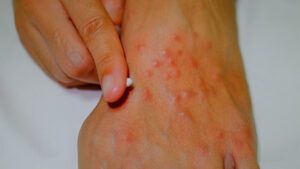
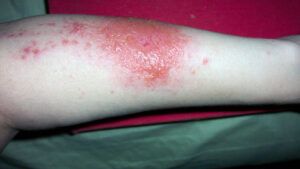

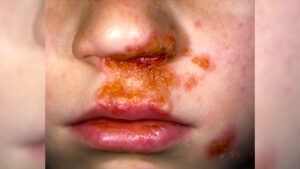

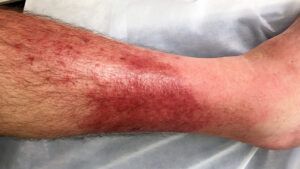
View the slideshow below for photos of shingles rashes.
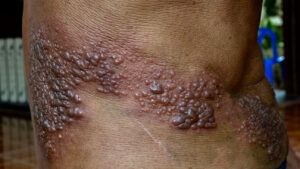

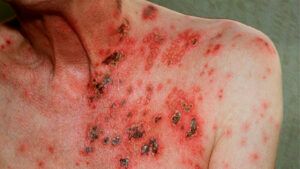

Warning
Contains Sensitive ContentBefore a shingles rash develops, a person may first experience:
- pain
- itching
- tingling
Next, the following may start to appear:
- a painful rash of blistering sores, which appears as a single stripe around one side of the body
- a rash around the eye
- fever and chills
- headache
- gastrointestinal symptoms
- a rash or ulcers in the mouth, known as oral shingles
Timeline
Different rashes can change over time. For example, herpes, which happens with exposure to the herpes simplex virus, causes blisters that can turn into sores, which then crust over. If a person has contact dermatitis, they
The timeline for a shingles rash can help to distinguish the condition from other types of rashes.
A shingles rash tends to develop in a hallmark pattern, usually on the trunk. People sometimes call it a “shingles band” due to the striped pattern. These rashes appear over
Pain occurs because the virus causes inflammation in the nerves.
Over the next
Disseminated shingles involves a widespread rash. It can affect people with weakened immune systems.
Learn more about what shingles looks like when it first starts.
Different rashes can take days or weeks to resolve. A person can make a note of how the rash develops and any changes that occur to help the doctor accurately diagnose shingles or any other condition responsible for the rash.
In some people, the rash heals, but the pain continues for
According to the
The best way to work out whether a rash is shingles is to contact a doctor. In most cases, a doctor can make a diagnosis according to a person’s medical history, a physical exam, and their symptoms. They may also take a sample of skin, mucus, or blood for testing to confirm the diagnosis.
A virus called varicella zoster
Once a person has a chickenpox infection, the virus remains in their nervous system, even after they recover. Although the virus stays in the body, doctors consider it latent, meaning it is inactive and does not cause any symptoms.
At some point, the virus can reactivate and cause shingles. The reason the virus reactivates is not entirely clear — it may become active again if a person’s immune system becomes weakened or stressed.
Other rashes can develop due to exposure to other viruses. A person’s doctor can order tests to determine if a virus is causing the rash.
Depending on the cause of the rash, a person may develop complications. Shingles may cause other complications besides PHN.
In some cases, shingles
- vision loss
- hearing loss
- pneumonia
- encephalitis, an inflammation of the brain
- partial facial paralysis
- polyneuritis, where multiple peripheral nerves become damaged
The virus may also affect the internal organs, such as the:
- lungs
- liver
- brain
- spinal cord
- blood vessels
In this case, it can become life threatening. Having a weakened immune system may increase the risk of internal involvement.
Contacting a doctor as soon as there are concerns about a rash may help reduce the risk of complications. It is important to receive an accurate diagnosis to ensure that a person can begin the right treatment as early as possible.
Learn more about the after-effects of shingles.
Here are some frequently asked questions about shingles.
What are the first signs of shingles?
Early symptoms include a feeling of pain, burning, and itching in one area of the skin. After this, a rash appears, and fluid-filled blisters form. The rash is painful because the virus causes infection in the nerve cells.
What are the triggers for shingles?
Possible triggers for shingles
Will shingles go away without treatment?
Shingles may clear up without treatment, but taking antiviral medication soon after the rash appears
Learn about home remedies for shingles.
How do you confirm you have shingles?
A doctor can perform a physical examination and order tests to confirm the diagnosis. This
How can you tell the difference between shingles and other rashes?
Some distinguishing features of a shingles rash are that it typically only affects one side of the body. A person may experience pain at the site of the rash before it develops, and the rash will blister before crusting over. However, it is best to contact a doctor for an accurate diagnosis.
Some conditions can cause symptoms that resemble a shingles rash. Examples include cellulitis, herpes simplex, impetigo, folliculitis, contact dermatitis, and oral thrush. Chickenpox, which also develops due to the varicella zoster virus, can also resemble shingles.
The symptoms and timeline of a shingles rash can help with accurately diagnosing the condition. The first symptoms of shingles can include pain, tingling, itching, and then a rash.
The rash often forms a band around one side of the body. In time, blisters can form. These usually scab over and heal within 2–4 weeks, but some people have ongoing pain known as postherpetic neuralgia.
It is best to contact a doctor for advice if a person develops a rash. As other conditions that can resemble shingles, a doctor may order tests to confirm the diagnosis.


